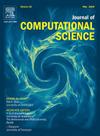Onco*: An umbrella Python framework for modelling and simulation of oncological scenarios
IF 3.1
3区 计算机科学
Q2 COMPUTER SCIENCE, INTERDISCIPLINARY APPLICATIONS
引用次数: 0
Abstract
The umbrella software Onco* provides a workflow for patient-specific tumour simulations. The general framework is exemplarily shown for brain tumours, where users are allowed to input medical image data or work with benchmark geometries. Three pre-processing Python packages generalise the magnetic resonance imaging series of the brain and segments the tumour and the heterogeneous microstructure of the tissue. The interpretation of collected information is followed by numerical simulations in a package, where users have the option to use pre-implemented model set-ups. These model set-ups can be customised, where each entity is editable, providing flexibility for ongoing development in the interdisciplinary field of tumour prediction. Two examples from a provided tutorial demonstrate the workflow and its capabilities from patient-specific and academic geometry input to potential tumour evolutions.
Onco*:一个用于建模和模拟肿瘤场景的伞形Python框架
伞形软件Onco*为患者特异性肿瘤模拟提供了一个工作流程。一般框架以脑肿瘤为例,允许用户输入医学图像数据或使用基准几何图形。三个预处理Python包概括了大脑的磁共振成像系列,并细分了肿瘤和组织的异质微观结构。对收集到的信息进行解释之后,将在包中进行数值模拟,其中用户可以选择使用预先实现的模型设置。这些模型设置可以定制,其中每个实体都是可编辑的,为肿瘤预测跨学科领域的持续发展提供了灵活性。提供的教程中的两个示例演示了工作流及其功能,从特定患者和学术几何输入到潜在的肿瘤演变。
本文章由计算机程序翻译,如有差异,请以英文原文为准。
求助全文
约1分钟内获得全文
求助全文
来源期刊

Journal of Computational Science
COMPUTER SCIENCE, INTERDISCIPLINARY APPLICATIONS-COMPUTER SCIENCE, THEORY & METHODS
CiteScore
5.50
自引率
3.00%
发文量
227
审稿时长
41 days
期刊介绍:
Computational Science is a rapidly growing multi- and interdisciplinary field that uses advanced computing and data analysis to understand and solve complex problems. It has reached a level of predictive capability that now firmly complements the traditional pillars of experimentation and theory.
The recent advances in experimental techniques such as detectors, on-line sensor networks and high-resolution imaging techniques, have opened up new windows into physical and biological processes at many levels of detail. The resulting data explosion allows for detailed data driven modeling and simulation.
This new discipline in science combines computational thinking, modern computational methods, devices and collateral technologies to address problems far beyond the scope of traditional numerical methods.
Computational science typically unifies three distinct elements:
• Modeling, Algorithms and Simulations (e.g. numerical and non-numerical, discrete and continuous);
• Software developed to solve science (e.g., biological, physical, and social), engineering, medicine, and humanities problems;
• Computer and information science that develops and optimizes the advanced system hardware, software, networking, and data management components (e.g. problem solving environments).
 求助内容:
求助内容: 应助结果提醒方式:
应助结果提醒方式:


